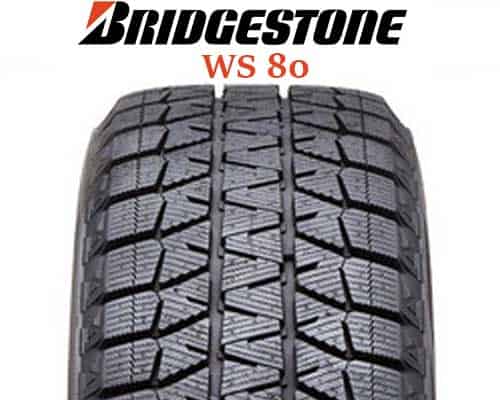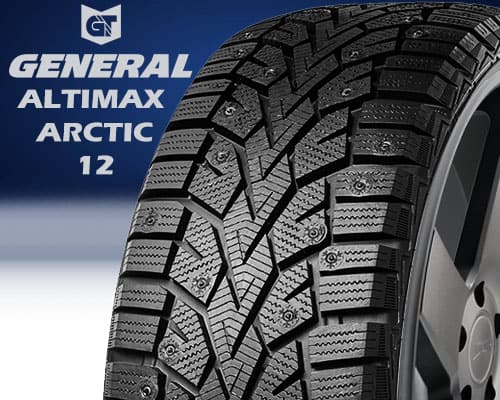Both the Bridgestone Blizzak WS80 and the General Altimax Arctic 12 are high-quality winter tires that offer flawless performance on icy and snowy terrains.
Even though both of them are winter tires, the WS80 is built to perform better on ice due to its lower void ratio which provides extra grip on icy roads.

Comparatively, the Arctic 12 provides better performance on soft snow due to its higher void ratio which is essential for grabbing and biting the snow. Keep reading to find out more about both of these tires in detail.
Table of Contents
Comparing Both Tires

Vs

The Blizzak WS80 features a snow-friendly design that favors extreme cold climatic conditions. The tire has two longitudinal groove sections that are spread over the middle part and consists of narrower grooves as compared to its competitor, allowing a higher contact patch.
As a result, the tire’s performance on dry and icy roads becomes superior.
Additionally, these tires are also equipped with more sipes that are deep as well. This is what makes their grip and handling effective on wet roads.
Coming to the General Arctic 12, the tire has an excellent tread pattern combined with adequate groove spacing. This is what favors these tires in snowy conditions.
The hydroplaning resistance of these tires is also excellent due to their higher void ratio.
The wider grooves of the Arctic 12 offer quick evacuation of mud, slush, and water from its grooves.
The lower rolling resistance of the tire is also incredibly effective due to the relatively wider grooves.
As a result, the tire’s fuel efficiency increases. Not only this, but it will also wear out slower than its competitor.
Grip Comparison
In comparison to General Arctic 12, the Blizzak WS80 consists of narrower grooves around its central ribs and shoulders. The densely packed tread pattern offers a maximum contact patch to the tire. This is what makes it capable of delivering splendid traction on dry roads.
In addition to this, the lower void ratio also helps in providing excellent grip while going at a high speed.
As a result, the vehicle’s stability is maintained. Its performance on wet roads is also increased due to the numerous sipes found over the entire tread. These sipes work marvelously to provide sufficient grip on wet roads. The multi tread cell compound also lets the drivers drive in harsh weather conditions without losing control.
However, when the tire is taken on the snow, its grip is reduced as it does not have wider grooves. But, the WS80 performs quite well on ice as it features more contact patch and numerous sipes as compared to the Arctic 12.
Considering the grip of General Arctic 12 on dry roads, its wide grooves reduce its contact patch.
This subsequently reduces the efficiency of the tire on dry roads. Since the traction is lessened, the braking distance also increases. As a result, the vehicle’s stability is compromised. Even though its wet traction is quite adequate, it is lesser than its competitor.
Also, there are sipes on the entire tread pattern but they are not as good as compared to its rival. However, the grip on the soft snow increases due to its wider grooves that strengthen the grip and as a result, the tire gets smooth mobility.
On the other hand, the traction on icy roads is not as reliable due to lower contact patches and lesser sipes.
Handling Comparison
Overall, the handling of these tires is almost similar but Blizzak WS80 performs better on dry roads. That’s because the shoulders of this tire are broader and cover quite a lot of tread.
This, as a result, provides additional lateral stability to them while turning over sharp edges. The sipes pattern on the tire also enables it to perform exceptionally well on wet roads.
However, its handling is a bit reduced in snowy conditions because of the narrower groves and lower void ratio.
On the other hand, the General Arctic 12 consists of wider grooves spreading all over the tread.
As a result, these tires feature a comparatively lower contact patch. The high void ratio results in compromising the handling while making turn over sharp edges on dry tracks.
The handling on wet and icy surfaces is also reduced due to wider grooves and a lesser number of sipes.
However, these tires display incredible handling on soft snow by throwing away the snow that gets stuck in the grooves. That’s because of the wider grooves and more space between its shoulder blocks.
Comparison of Hydroplaning Resistance
The hydroplaning resistance of both tires is satisfactory. However, the Blizzak WS80 loses to its competitor due to the narrower grooves which result in a lower void ratio.
The narrower grooves are incapable of evacuating the water efficiently which makes these tires vulnerable to hydroplaning.
Comparatively, the General Arctic 12 provides satisfactory hydroplaning resistance due to its wide grooves, deep sipes, and excellent design.
The impressive sipes on each section of the tread block efficiently wipe away the water and provide resistance to hydroplaning.
Comparison of Rolling Resistance
The broad design of Blizzak WS80 along with more contact patches increases the tire’s surface area that comes in connection with the road.
As a result, the rolling resistance of the tire is increased and its fuel efficiency is also compromised. So, this tire will provide relatively less mileage.
In comparison, the General Arctic 12 has wider grooves which reduce its contact patch. This will reduce the drag force and thus, the driver will require less effort to maintain the tire’s mobility.
Due to the reduced rolling resistance, the fuel efficiency of the tire is also improved and also provides better mileage.
Durability and Treadwear
Talking about the durability and the treadwear of the Blizzak WS80, it features a multi-cell pattern which makes it a favorable tire for extremely cold conditions. Its micro-texture pattern and the longitudinal tread blocks provide a neat finish to the tire without compromising the grip on the surface.
However, the tire has a relatively higher contact patch which will increase the chances of faster treadwear. But, on the brighter side, the customers get a 5-year warranty on these tires extending from the date the tire was manufactured.
The Arctic 12 features a winter-focused design molded into an incredibly high directional tread pattern. The rigid and arrow-shaped central rib offers a solid steering response and an on-central feel.
In addition to this, the optimized tread contour further aids in the distribution of the pressure across the footprint. As a result, the wear of the tire improves as compared to the older generation tires.
Moreover, since the rolling resistance of these tires is lower, they will wear out slower than their competitor. The users also get a material warranty of 6 years along with the free replacement in the first year.
Do they offer good value to money?
If we talk about the price of both the tires in size 205/55R16, it’s almost the same only with little difference. Bridgestone tire costs a bit more than the General Altimax.
However, the selection of the tire completely depends upon the user requirements. So, you can pick the one that you find suitable.
Take Home Points:
Both tires are severe winter rated and are branded with 3 peak mountain snowflake symbol. So winter performance on both tires are almost similar, though Bridgestone WS80 does a little better on icy roads.
If we talk on road traction, the grip is slightly better on this tire as well, but the General Arctic is better in terms of wear and fuel efficiency.